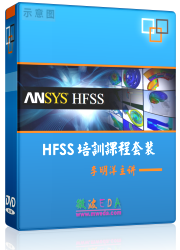比較經典:關于driven modal 與driven terminal 的理解,以及兩種波端口的區別!
文章來源: 互聯網 錄入: mweda.com
本文轉自百思網站,由sonofsky原創().
再次轉載請說明原出處,在此感謝sonofsky把經驗分享給大家!
關于driven modal 與driven terminal 的理解
1. driven modal 模式驅動, 所謂模式驅動就是hfss根據用戶所定義的模式數目求解端口模式數目及場分布,并為每個模式分配相等的功率,仿真時用端口場分布做為邊界條件對內部進行求解,默認端口阻抗為Zpi 無須定義積分線來求解電壓, S參量用入射反射功率來表示
2. 對于分析偶合傳輸線等一個端口上有多個終端,而求解終端之間偶合問題的模型,driven modal 是不適合的.應用driven terminal ,這里以微帶偶合傳輸線為例子說明這個問題
在這個端口上tem波 有兩種模式 1.偶模:V1=V2 2.奇模. V1=-V2 (V1為導體1對接地板等效電壓, V2為導體2對接地板等效電壓) 如果用driven modal求結 則這兩種模式分別被賦予相等功率,而求解出的S11則是整個端口上的每一種模式的反射情況,而不能直接求出兩線的偶合狀況(例如只激勵導體1,求導體2上的端口電壓)這顯然是不合適的.
(關于偶合傳輸線問題詳情見microwave engineering edition 3 7.6節)
Driven terminal默認的求解終端阻抗為Zvi 故對于每個終端需要定義積分線,例如上圖中terminal 的積分線為從接地版到導體1的連線(導體1,接地版都為等勢體,路徑沒有關系),terminal2的積分線為接地版到導體2) 計算機求解時對兩個終端分別進行激勵,通過電壓與電流來計算他們之間的偶合關系.
3總結
1. 如果模型中有類似于偶合傳輸線求偶合問題的模型一定要用driven terminal求解,
2. driven modal適于其他模型, 但一般tem模式(同軸,微帶等)傳輸的單終端模型一般用driven terminal分析 (tem波電壓一般由兩導體之間電場積分定義,電流為環線磁場的積分,阻抗Zvi=Zpi=Zpv區別于TE TM) 由于其直接對電流電壓求解而避免了對整個面上功率的計算從而比較簡便.
微波EDA (www.ostronger.com) 網友回復:
-
網友回復
HFSS---the difference between wave port and lump port
With lump port=> the excitation is applied at a point/cell, as a voltage or current.
With wave-port=> the excitation is so-called eigen-wave, such as the quasi-tem wave supported by a microstrip line. It applies over a cross-sectional area.
voltage is scalar, wave is vector by nature, hence there are substantial difference between the two. So use waveport whenever possible, because "simulation of wave phenomenon" is what HFSS is designed for. And compare with the "correct" measurement whenever possible (i.e. measure "wave", not simply "voltage").
Why lumped port is there? It is easy to applied and people found that good/reasonable results can be obtained. Why? if the frequency is low enough or the excitation is applied at sufficiently small area, then the "wave" can be described by some "voltage" or "current", which must be "measured"/"calculated"/de-embedded/etc in the correct manner.
if the excitation can be applied on some locally uniform region=>waveport,
if geometry/material discontinuities are near/closer to the point of excitation=>lumped port might be the only way.
The subject of lumped vs wave port is actually complicated. people continue to study related matters, (e.g. arguing what is the "characteristic impedance").
Reading about the various de-embedding scheme should help with the understanding.... -
網友回復
個人覺得其在總結上面第2點中,應該是同軸線和偶合線用driven terminal.可能是作者筆誤! -
網友回復
感謝分享 -
網友回復
不錯,頂頂 -
網友回復
真的很經典,真的很經典
。。。。。。。。。 -
網友回復
謝謝指點!!!! -
網友回復
好!!!!!!!!!!!!!!!!!!!!!!! -
網友回復
多謝老畢啊 -
網友回復
原來是。。。。。。。。。。。
那我得頂一個
申明:網友回復良莠不齊,僅供參考。如需專業解答,推薦學習李明洋老師的HFSS培訓視頻,或咨詢本站專家。
-

國內最全面的HFSS培訓課程,包含7套視頻教程和2本教材,資深專家講解,視頻操作演示,結合最新工程案例,讓HFSS學習不再難...【詳細介紹】
- s參數仿真結果與文獻不一致,…
如何用HFSS仿真一端微帶線
免費下 801頁的hfss full bo…
AppCAD
新手請教:硅的epsilon/介電…
新手請教:HFSS里加的激勵Ex…
我錯在那里
關于HFSS使用
差分線波端口的設置問題
Hfss中lumped port 設置問題
- · HFSS視頻培訓課程
- · HFSS電磁仿真設計應用詳解-在線閱讀
- · HFSS教程
- · HFSS百科問答

